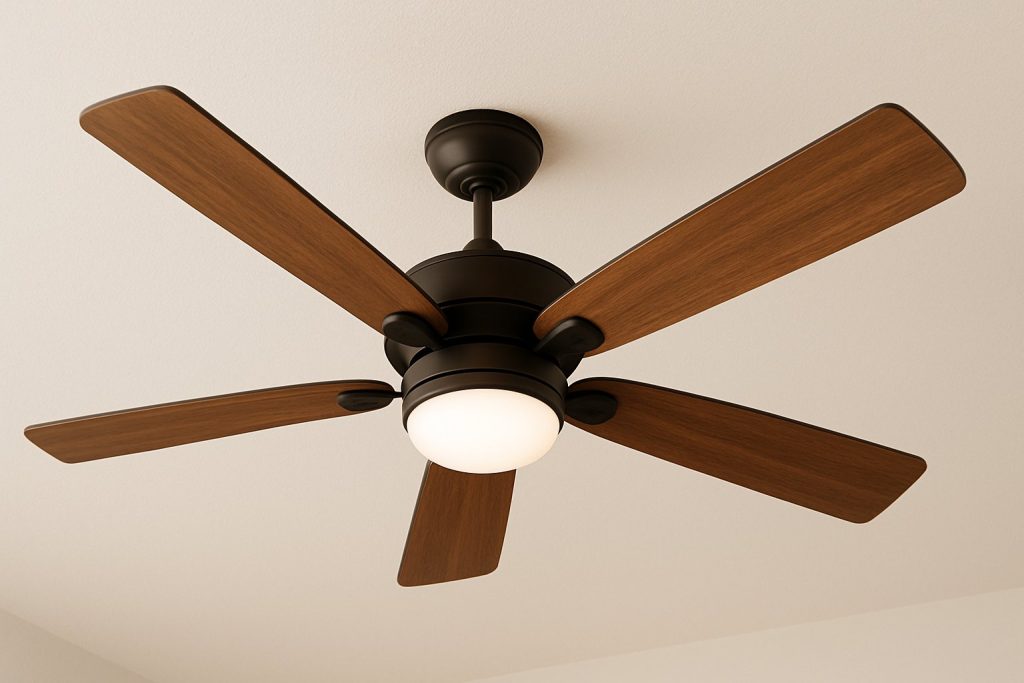With energy prices rising across Australia, more homeowners are looking for ways to reduce their electricity bills without sacrificing comfort. Ceiling fans are often recommended as an energy-efficient solution, but do they really make a noticeable difference? Let’s break it down.

How Ceiling Fans Work
Ceiling fans don’t cool the air like air conditioners. Instead, they move air around the room, creating a wind-chill effect that makes you feel cooler. This allows you to set your air con to a higher temperature, or skip using it altogether during milder days, without feeling hot or stuffy.
Unlike air conditioning systems that consume large amounts of power to cool the air, ceiling fans work with the body’s natural cooling process. When the air moves across your skin, it speeds up evaporation of sweat, making you feel cooler. This simple mechanism can help you stay comfortable without over-relying on energy-hungry appliances.
How They Help Cut Power Bills
Running a ceiling fan uses significantly less electricity than an air conditioning system. For example:
- A typical ceiling fan costs about 2–3 cents per hour to run.
- A split-system air conditioner can cost around 20–40 cents per hour, depending on its size and efficiency.
If you run a fan instead of air conditioning for several hours a day, those savings quickly add up. Even when used together, a ceiling fan can help spread the cool air more effectively, meaning your air conditioner doesn’t have to work as hard or run as long.
Let’s say you switch from using your air conditioner exclusively to using a ceiling fan for half the time; your energy usage could drop by more than 30% over the course of a summer. Multiply that across a few rooms and a few months, and it’s easy to see how fans can make a real dent in your energy bills.
Tips for Maximising Energy Efficiency with Fans
- Use fans strategically: Only use ceiling fans in rooms that are occupied. Fans cool people, not rooms.
- Set your air con a few degrees higher: With a fan running, you can stay just as comfortable at 24°C or 25°C, rather than 21°C.
- Switch fan direction in winter: Most modern ceiling fans have a reverse setting. This helps push warm air down from the ceiling, reducing heating costs.
- Choose energy-efficient fan models: Look for fans with energy ratings or DC motors, which use up to 70% less energy than traditional AC motor fans.
- Install timers or smart switches: These help ensure fans aren’t running unnecessarily, saving more energy in the long run.
Ceiling Fans for All Seasons
Many Aussies don’t realise that ceiling fans aren’t just for summer. When used properly, they also improve warmth distribution in winter. This year-round functionality makes them a smart, low-cost addition to any home.
In winter, warm air tends to rise and sit near the ceiling. Switching your fan to reverse mode circulates that warm air back down to where you need it, helping to reduce reliance on heaters and improving overall energy efficiency.
Environmentally Friendly Comfort
Using ceiling fans more and relying less on air conditioning helps reduce your carbon footprint. It’s a win for both your wallet and the planet.
With less demand on the electrical grid and fewer greenhouse gas emissions, fans are a sustainable solution for comfort. They’re especially effective when combined with passive cooling strategies like good insulation, window coverings, and cross-ventilation.
Ceiling fans absolutely can help lower your power bill, especially when used wisely in combination with your existing cooling and heating systems. They’re affordable to run, kinder to the environment, and effective year-round. If you’re looking for a budget-friendly, energy-saving upgrade, a ceiling fan is a smart investment. Contact Airmelec today, and we’ll help you find the perfect ceiling fan solution that suits your lifestyle and space.

